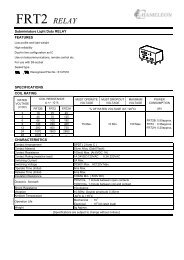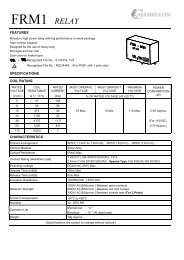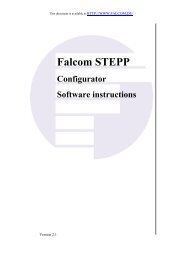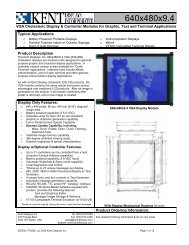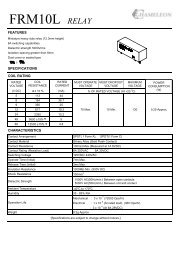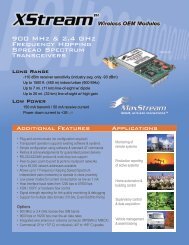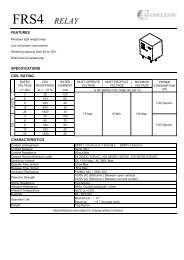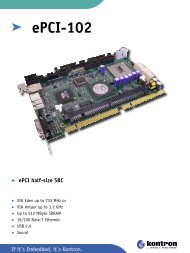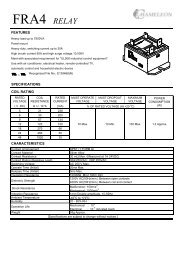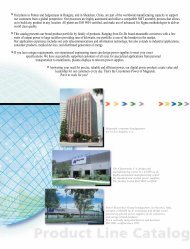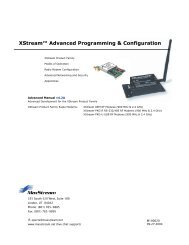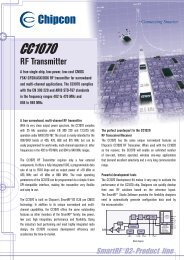STANDARD SERIAL COMMUNICATION INTERFACE and ...
STANDARD SERIAL COMMUNICATION INTERFACE and ...
STANDARD SERIAL COMMUNICATION INTERFACE and ...
Create successful ePaper yourself
Turn your PDF publications into a flip-book with our unique Google optimized e-Paper software.
St<strong>and</strong>ard Serial Interface Protocol Description<br />
# (Field 4) (Field #5) (Field #6)<br />
# Cmd. Content<br />
Byte Typical Content Byte Message Description<br />
Designation<br />
Count<br />
Count<br />
15 "U” 2 N/A 0 Inform Sign its configuration.<br />
<br />
16 "V” N/A 0 N/A 0 Sign Firmware ID Request.<br />
Host will receive a sign<br />
message after positive<br />
response is received.<br />
17 "W” 1 N/A 0 Display Message # X already<br />
loaded on Sign.<br />
18 "X" N/A 0 N/A 0 Blank Sign (all sign rows)<br />
* 19 “Y” , ,<br />
,<br />
<br />
4 Sign Row 1<br />
Text!, ETX<br />
Variable Load Text-based Sign<br />
message #X into memory.<br />
Does not display until “W”<br />
cmd. RX’ed.<br />
* 20 “Z” , , <br />
* 21 “>”<br />
(3e in Hex)<br />
3 N/A 0 Start Automatic Message<br />
Cycling for messages<br />
indicated, the amount of cycles<br />
specified (all #’s in hex)<br />
N/A 0 N/A 0 Clear All Previously Received<br />
Message Data (overides any<br />
previous Message trigger or<br />
Automatic cycle comm<strong>and</strong><br />
received).<br />
* Indicates Y & Z comm<strong>and</strong> are used together in place of A-H <strong>and</strong> T comm<strong>and</strong>s, <strong>and</strong> are only available on QUADs (along with “>”<br />
comm<strong>and</strong>) with 13028 Revision C firmware, or later.<br />
% indicates respective comm<strong>and</strong> should not be used for new designs. Y, Z & > comm<strong>and</strong> set should be used instead.<br />
Table 5.3.1B: Available Host Computer QUAD Application Layer Comm<strong>and</strong>s (Continued)<br />
Where:<br />
1. Text data for all rows of a sign are to be combined into a single application layer message packet,<br />
where:<br />
a. EOT = End of Sign Row Text Comm<strong>and</strong> byte (04 Hex). An EOT byte received without<br />
any prior text data will inform the respective sign that data elements for the respective<br />
sign row are not to be changed for the respective message #. The text data for the last<br />
row of the sign is not to be terminated with an EOT character.<br />
b. ETX = End of Transmission Comm<strong>and</strong> byte (03 Hex). Indicates end of application layer<br />
message packet.<br />
2. = Three consecutive bit mapped binary<br />
bytes indicating the sense of display messages (Normal mode = Reflective text/image with<br />
transparent background) 1 through 23. A "1" bit in the any of the following bit assignments<br />
for the 3 bytes will comm<strong>and</strong> the respective message into inverted mode (transparent<br />
text/image with reflective background):<br />
• Bit 7 (Left-most, or M.S.B.) - Message #1 (Msg_Sense Cmd_Byte1), Message #9<br />
(Msg_Sense Cmd_Byte2) & Message #17 (Msg_Sense Cmd_Byte3) image sense<br />
assignment.<br />
• Bit 6 - Message #2, Message #10 & Message #18 sense assignment.<br />
• Bit 5 - Message #3, Message #11 & Message #19 sense assignment.<br />
• Bit 4 - Message #4, Message #12 & Message #20 sense assignment.<br />
St<strong>and</strong>ard Serial Communication Interface Description, © 1998-2002 Kent Displays Inc., doc. # 25016 Revision T, Page 18 of 52



